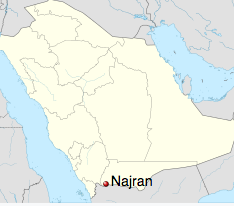
It is widely known that Saudi Arabia permits neither Jews nor Christians to become citizens, nor will it officially allow Jewish travellers to enter. But until 1934, the year when the kingdom was established, Jews lived at its southern tip, at Najran. However persecution forced hundreds of Najrani Jews to seek shelter in the neighbouring kingdom of Yemen and Aden. Together with the majority of Yemen’s Jews, the Najrani Jews were airlifted to Israel in 1949. (With thanks: Lily)
The Jewish Virtual Library has this entry:
According to Yemenite Jewish tradition, the Jews of Najrān trace their origin to the Ten Tribes. They lived in the region of Najrān in Saudi Arabia and were the only group of Yemenite Jews who lived outside Yemen under the rule of another kingdom. On the strength of the laws of the desert and tribal protection, they were not subjected to persecution as were the Jews of Yemen.
They enjoyed the same equality of rights as the Arabs of Saudi Arabia, were not taxed, and did not pay the *jizya (the poll tax imposed on non-Muslims in the Muslim countries “in exchange for the protection” granted them by the government). The Bedouin of Saudi Arabia, who belonged to the Sunni Islam sect, practiced religious tolerance toward them and ate meat slaughtered under their laws of sheḥitah. The Jews of Najrān carried weapons in self-defense, as did the other inhabitants, and were renowned for their courage and strength.
There was no other place in the Arabian Peninsula where Jews lived in such dignity and freedom as in Najrān. By profession they were craftsmen: they worked essentially in goldsmithing and repairing arms. They earned a good livelihood and their material conditions surpassed those of Yemenite Jews. Their settlements were scattered throughout Najrān in small units of two to forty families. They lived in clay houses or in huts. Their clothes, of both men and women, were slightly different from that of Saudi Arabians and Yemenite Jews.
The strict barrier between men and women, which was customary in social life throughout Yemen, was nonexistent among them. At festivities and celebrations men and women sat together and women danced to the sound of the men’s singing.
After 1936, their relations with Yemenite Jews were not very close, because the two groups were under the rule of different kingdoms which occasionally were at war with each other. The life of the Jews of Najrān, dispersed as they were in small settlements, did not encourage the development of Torah studies among them or the fostering of an independent spiritual culture. In matters of religion and halakhah they were dependent on the community of nearby Saʿdah (one day away from them), and when necessary, on the bet din of *Sanʿa.
The Jews of Saʿdah served as their spiritual guardians in times of need: they provided them with religious books and guided them in their religious practices. Therefore, their prayers, customs, and system of study were very closely related. In Israel they are concentrated in Kiryat Ekron, which is inhabited by the Jews of Saʿdah. When the Jews of Najrān immigrated to Israel in 1949, they numbered about 250.
According to Wikipedia :
The Yemeni city of Najran was conquered by Saudi forces in 1934, absorbing its Jewish community, which dates to pre-Islamic times.[7] With increased persecution, the Jews of Najran made plans to evacuate. The local governor at the time, Amir Turki ben Mahdi, allowed the 600 Najrani Jews[8] a single day on which to either evacuate or never leave again. Saudi soldiers accompanied them to the Yemeni border. These Jews arrived in Saada,[9] and some 200 continued south to Aden between September and October 1949. The Saudi King Abdulaziz demanded their return, but the Yemeni king, Ahmad bin Yahya refused, because these refugees were Yemenite Jews. After settling in the Hashid Camp (also called Mahane Geula) they were airlifted to Israel as part of the larger Operation Magic Carpet.[10]

Leave a Reply